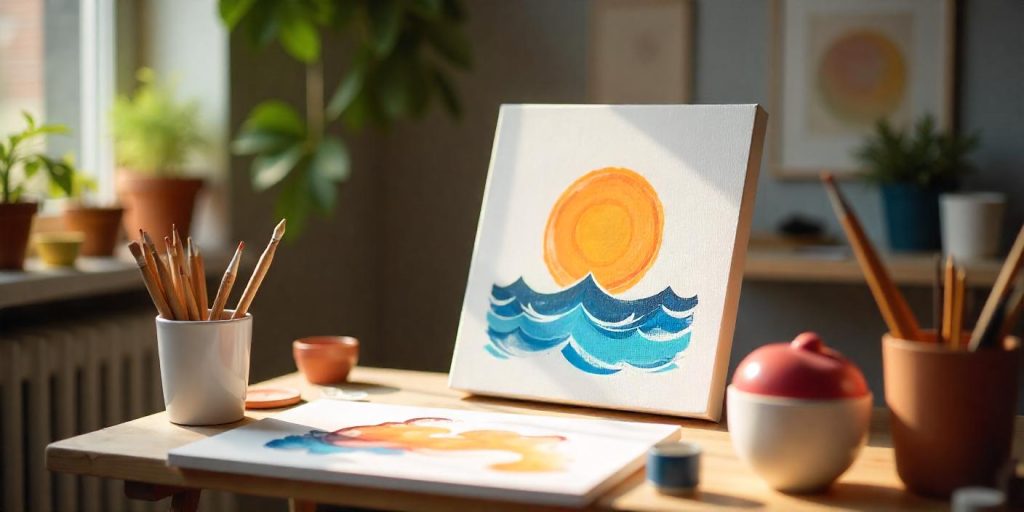Painting foam can transform ordinary materials into stunning pieces for crafts, DIY projects, or décor. However, foam requires specific techniques to ensure a smooth, lasting finish.

This step-by-step guide will show you how to paint foam effectively and avoid common pitfalls.
Contents
Materials You’ll Need
Foam Types
- Polystyrene (Styrofoam): Common for crafts but prone to melting if painted incorrectly.
- Polyurethane Foam: Denser and ideal for furniture or props.
Tools and Supplies
- Acrylic paint or spray paint (foam-safe)
- Paintbrushes or rollers
- Primer (optional, foam-specific)
- Sandpaper (fine-grit)
- Drop cloth or newspaper
- Masking tape (optional for edges)
- Protective gear (gloves, mask, and goggles)
Step 1: Choose the Right Paint
Acrylic Paint
Acrylic is water-based, making it safe for most foam surfaces. It’s versatile and easy to apply.
Spray Paint
Ensure the spray paint is labeled as “foam-safe.” Regular spray paint can dissolve certain types of foam.
Specialty Paints
For detailed projects, look for paints specifically designed for foam or plastic surfaces.
Step 2: Prepare the Foam
Clean the Surface
Wipe down the foam with a dry cloth to remove dust and debris. Avoid using water, as some foams absorb moisture.
Sand the Surface
Use fine-grit sandpaper to smooth uneven areas. This step is essential for dense foams like polyurethane.
Apply a Primer
Priming is optional but recommended for smoother coverage and better adhesion. Use a foam-specific primer and let it dry completely.
Step 3: Protect Surrounding Areas
Lay Down a Drop Cloth
Cover your workspace with a drop cloth or newspaper to protect against paint drips and spills.
Use Masking Tape
If painting only certain areas, apply masking tape to protect the edges or adjoining surfaces.
Step 4: Paint the Foam
Painting with a Brush
- Dip the brush in acrylic paint and remove excess paint to avoid streaks.
- Apply in thin, even layers. Allow each layer to dry before adding the next.
Using Spray Paint
- Hold the can 8–12 inches away from the foam surface.
- Spray in a sweeping motion to ensure even coverage.
- Let the paint dry before applying additional coats.
Step 5: Let the Paint Dry
Air Dry
Place the foam in a well-ventilated area to dry. Avoid direct sunlight, as it can warp certain foams.
Drying Time
Most acrylic paints dry within 20–30 minutes between coats. Complete drying may take a few hours.
Step 6: Add Finishing Touches
Seal the Paint
For added durability, apply a clear foam-safe sealant. This is especially useful for projects exposed to moisture or frequent handling.
Add Details
Use small brushes for intricate designs or embellishments.
Tips for Success
Test Paint Compatibility
Before starting, test your chosen paint on a scrap piece of foam to ensure it doesn’t melt or warp.
Avoid Overloading Paint
Too much paint can seep into the foam, causing uneven drying or warping.
Use Multiple Coats
Thin, even layers result in better coverage and minimize the risk of damage.
Common Mistakes to Avoid
Using the Wrong Paint
Always use foam-safe paints to prevent damage.
Skipping Primer
Priming ensures a smooth finish and reduces the number of paint coats needed.
Rushing the Drying Process
Allow each layer to dry thoroughly before applying the next to avoid smudging or peeling.
Creative Foam Painting Ideas
DIY Props
Paint foam to create realistic props for theater, cosplay, or parties.
Home Décor
Customize foam panels for unique wall art or centerpieces.
Seasonal Crafts
Paint foam for holiday decorations like Halloween tombstones or Christmas ornaments.
Conclusion
Painting foam is a rewarding and versatile project when done correctly.
By choosing the right materials and following these steps, you can achieve professional-looking results. Experiment with colors, textures, and designs to bring your foam projects to life!
